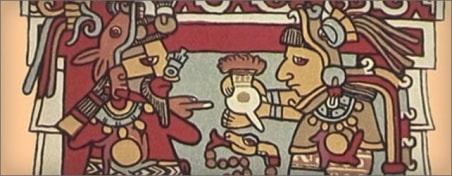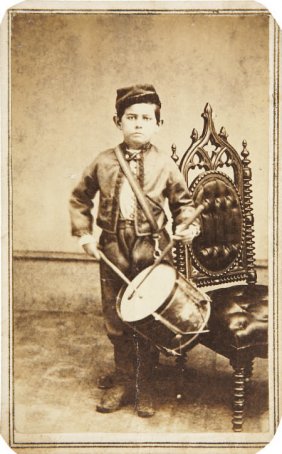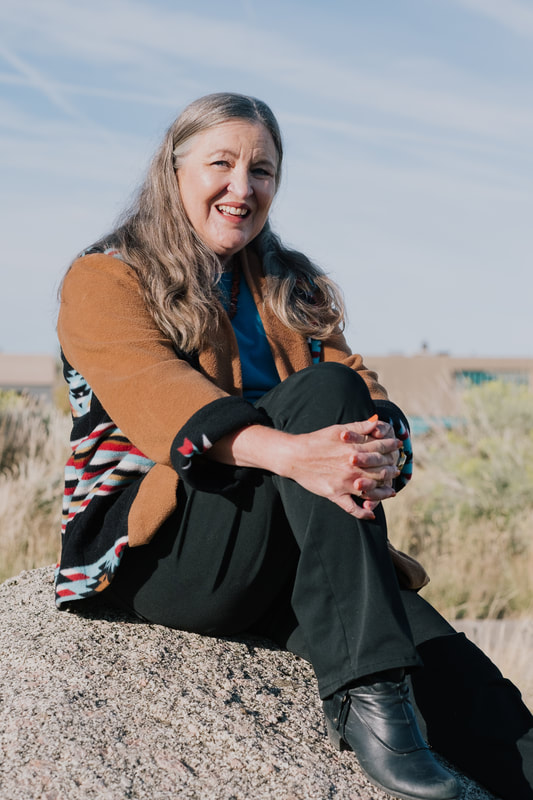 Jicaras, or chocolate cups from Abo and Quarai New Mexico, 17th C.
Jicaras, or chocolate cups from Abo and Quarai New Mexico, 17th C. 
 Jicaras, or chocolate cups from Abo and Quarai New Mexico, 17th C. Jicaras, or chocolate cups from Abo and Quarai New Mexico, 17th C. Chocolate made its way up to New Mexico through the same trade routes that brought scarlet macaw feathers to Chaco Canyon. The same residue found in ancient Olmec bowls has been found in the pottery of the Four Corners region, and it dates perhaps a thousand years back. The Spanish reintroduced cacao into New Mexico when they began exploring the region. In 1692, Diego de Vargas, the Spanish Governor of New Mexico, met with a Pueblo leader names Luis Picuri in his tent. The meeting included drinking chocolate.  The Palace of the Governors, New Mexico’s History Museum, has on display some artifacts that are associated with chocolate. This storage jar was used to keep cocoa powder. New Mexico was quite isolated and life was rough here. People had few luxuries. The fact that cocoa was stored in such an ornate jar, with a metal lid indicated just how highly prized it was. This is a molinillo, or chocolate whisk, from about 1830. The large end would be placed in the pot of hot chocolate and the thin handle was held between the palms of the hands and spun to make the beverage frothy. Want your own molinillo? Jennifer Bohnhoff will be giving one away, along with a package of Mexican chocolate, and a cookbook that contains a recipe for a traditional New Mexican chocolate drink. Join her Friends, Fan, and Family email list by February 1 to be entered in the drawing. Sign up here.
0 Comments
 When I think of hot chocolate, I think of mugs of warm, sweet comfort. I lived in Massachusetts for three years in my childhood and have many memories of sledding until my fingers and toes burned with cold, then rushing home to cocoa in a steamy kitchen. I also think of a warm chair by the fire, and curling up with a good book. But hot chocolate didn’t originate in the frozen north, and its history has more to do with diplomacy than comfort.  Still from a YouTube video on cacao production. Still from a YouTube video on cacao production. Chocolate is made from the fruit of cacao trees. These small trees are native to Central and South America. They produce fruits, called pods, that are roughly the size of a person’s hand and are shaped like footballs. Within their tangy-sweet, gummy white flesh, each pod contains around 40 cacao beans that are bitter in taste and nothing like the chocolate we know and love. It appears that the ancient Olmecs of southern Mexico were the first to dry and roast cocoa beans. Because they kept no written history, it’s hard to know exactly where, when, or why the Olmecs began processing cacao beans, but pots and vessels dating back to around 1500 B.C. have traces of theobromine, a stimulant compound found in chocolate. Archeologists believe that early recipes were for drinks or gruels that were likely very bitter and used for ceremony rather than pleasure.
After the Olmecs, the Mayans continued to use chocolate. Fortunately for historians, the Mayans kept written records, and through them we know that Mayan chocolate was thick and frothy. It often included chili peppers and honey. We know that cacao drinks were commonly drunk in everyday situations, and became part of the Mayan identity like wine is to the French, coffee to the Arab world, or craft beer to many locations today. Records indicate that many Mayan households drank chocolate with every meal. But cacao wasn’t just a drink. Mayan written history indicates that chocolate drinks were incorporated into religious ceremonies, were used in celebrations, and helped finalize important transactions. These beverages were part of initiation rites for young men and celebrations marking the end of the Maya calendar year. In the early 12th century, chocolate was part of the dowry used to seal the marriage of a Mixtec ruler in the sacred Valley of Oaxaca. The Aztecs continued the love of cacao beans, which they considered more valuable than gold. Although it’s likely that Spanish historians have exaggerated, they claimed that Montezuma drank fifty cups of chocolate each day, both for the energy it gave him, and as an aphrodisiac. It’s likely that Spanish conquistador Hernan Cortes was introduced to chocolate by Montezuma and in turn introduced it to the Spanish court of Philip II of Spain in 1544. Two weekends ago my husband and I took a little trip to Santa Fe. We spent a very delightful morning wandering through the New Mexico History Museum. New Mexico's History Museum has a lot of history, even without the exhibits it contains. It is housed in a building called The Palace of the Governors, which was built by Pedro de Peralta soon after the King of Spain appointed him to be the governor of a Spanish territory that covered most of the American Southwest. That was 1610. Governors appointed by Spain, Mexico, and America have used the building, and it has served many other functions besides governor's mansion and museum. It is the oldest continuously occupied public building in the United States.  I went specifically to see the relatively new exhibit on New Mexicans who served during WWI, but I don't have much to report on that. What did impress me, though, was a snare drum that I hadn't noticed before. This snare drum, the label indicated, was found in the Pecos River about a decade after the Battle of Glorieta Pass.  Willie, as I imagine him Willie, as I imagine him Those of you who've read Valverde, the first book in my trilogy of Civil War novels set in New Mexico, will know that it has a Confederate Drummer Boy named Willie. Willie is a fictional character, but this is exactly what I think he looked like: small and dark eyed, with a pale, round face. The drum that he would have carried into the battle of Valverde and, if he were there, the Battle of Glorieta Pass, looks very much like the one that was found abandoned in the Pecos River. I'm presently writing a first draft of Glorieta, the second book in the series, and I'd had other plans for Willie than for him to lose his drum in the Pecos River. However, sometimes real life interprets fiction. I just may have to have him lose his drum in the river somehow.  Valverde is available in paperback and ebook from Amazon. If you want more information on Valverde, or would like to buy a signed copy directly from the author, click here. There is also a drummer boy in The Bent Reed, my civil war novel set in Gettysburg. On the last day of last year I posted a story about an amaryllis bulb that had started to grow while stick in the box. I didn't think it would amount to much, but I was impressed with how determined it was to become all it could be. You can read that blog entry and see a picture of that first, failed, flower here.  That determined little bulb has surprised me. After I cut off the first, stunted blossom, the leaf part started to stand straight. It's turned green. And surprise of surprises, it has two more flower blossoms coming! There's a big moral here for everyone: sometimes life is hard. Sometimes it can leave a person a little damaged. But perseverance - that quality now popularized as grit - can see you through. I'll continue to post pictures of my miracle amaryllis. I'm hoping to follow its lead and make this year the year that I overcome a lot of obstacles, stand tall, and really bloom where I am planted. Here's wishing the same for you.  Jennifer Bohnhoff is a middle school English teacher in rural New Mexico and the author of a number of novels for middle school and above. You can learn more about her books here.  Ever have manic mornings when you wish you could get something good, hot, and satisfying on the table quickly? I know I do. Having Manic Muffin Mix in your pantry might just help. Today I'll post the recipe for the mix and for basic muffins. On the first Monday of every month throughout 2019 I'll post a new recipe that uses the mix. That adds up to 12 different muffins that I hope will take a little of the mania out of your mornings. Manic Muffin Mix 9 cups flour 2 1/2 cups sugar 1 cup buttermilk blend 3 TBS baking powder 1 TBS baking soda 1 TBS salt 1 1/2 TBS cinnamon 1 1/2 tsp nutmeg Mix all ingredients well and store in a sealable container.  Everything in this recipe is a common pantry staple with the exception of buttermilk blend. I use Saco Pantry Cultured Buttermilk Blend, which is kept next to the yeasts and baking powders in my local grocery store. If you can't find this, or a similar product, substitute powdered milk and your muffins will turn out just fine. Basic Manic MuffinsThese are sweet and a little spicy. Making up a batch will make your kitchen smell wonderful. I recommend you put out butter and jelly to go on them, but my husband likes to split them and slather them with peanut butter. Preheat oven to 350. Put muffin papers in 12 standard-sized muffin cups, or grease cups with spray oil.  Mix together in a large bowl. The batter should be slightly lumpy: 2 eggs 1 1/2 tsp vanilla 1 cup water 1/2 cup oil 2 3/4 cup manic muffin mix. Fill muffin cups 3/4 full. Bake for 18-20 minutes until the tops of the muffins are golden. These muffins freeze well. If your family is small, I recommend putting single muffins in sandwich bags, then putting them all in a ziplock freezer bag so you can pull them out one at a time. Frozen muffins are ready to serve after being reheated in the microwave on high for 30 seconds. Jennifer Bohnhoff writes fiction for middle schoolers and adults, but she has to eat, too. You can find out more about her at her website or Facebook page.
|
Don't see what you're looking for?
I am in the process of moving all my blog entries to a different blog site. Eventually, this page will go away. If you're looking for something and it's not here, try my new site, or email me and suggest I write a blog on the topic you are interested in. 
ABout Jennifer BohnhoffI am a former middle school teacher who loves travel and history, so it should come as no surprise that many of my books are middle grade historical novels set in beautiful or interesting places. But not all of them. I hope there's one title here that will speak to you personally and deeply. Categories
All
Archives
March 2025
|